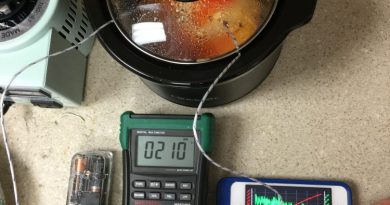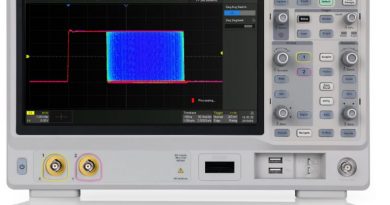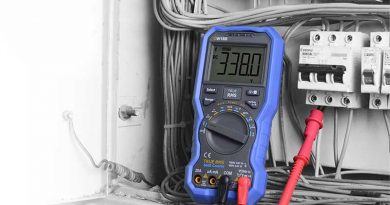Product Review: HANTEK DSO5102B 100MHz Digital Storage Oscilloscope
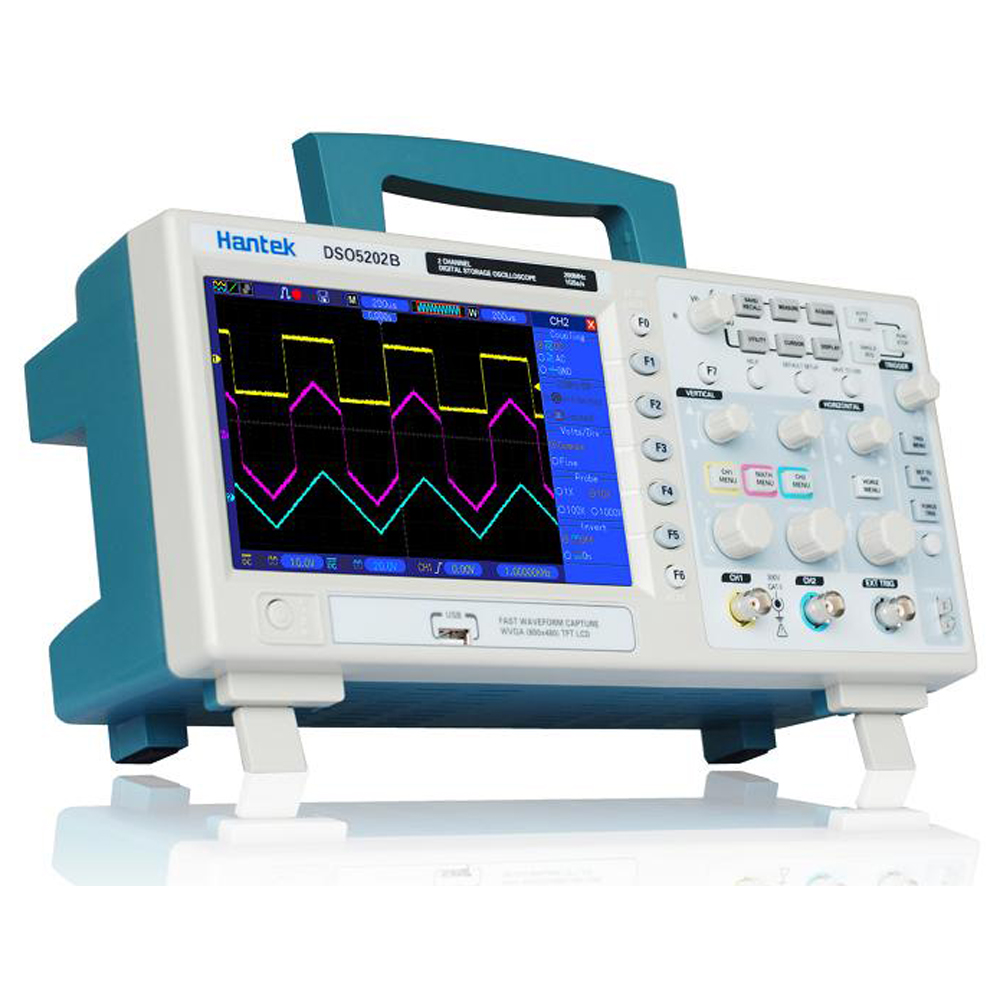
HANTEK DSO5102B 100MHz Digital Storage Oscilloscope
(Customer submitted review)
by: Marius Raymond
About 15 years ago, I made a leap of faith & upgraded from my old creaky analog oscilloscope to the newest and best digital storage oscilloscope. I felt that this was a necessary step if I were to continue doing electronic design work.
So, I dug deep and ended up with a brand new 100 Mhz 2 channel DSO from Tektronix ( TDS320 ). By my recollection, it cost me about $4,000.00 but its been a long time so I could be off a bit on that figure. Anyway, it was a huge amount of money for me at the time but it provided all of the features and capabilities that I would need for many years of design & diagnostics.
And in fact, the Tek model provided me with great service and was flawless until very recently when it just died and went to oscilloscope heaven. I contacted Tektronics about a repair and was told I could get a non guaranteed repair for $1500.00. I’m not sure if the repair would not have a warranty period or that they were saying they wouldn’t guarantee they could even repair the unit because of its age. In any case, $1500.00 squelched the deal either way.
So with all of that considered, I decided to see about acquiring a new DSO. I began by searching the internet to see what might be available and at what kind of price. What struck me was a realization that the DSO had really evolved tremendously since I had made the huge investment in the Tektronix TDS320. Most of the units I saw offered full color Liquid Crystal Display screens . The weight & size difference between the LCD & the old CRT display is huge and the result is that the units I found were dramatically smaller & lighter than what I was used to plus the displays are much clearer and easier to analyze.
There was also a significant increase in sampling rates and an even more dramatic increase in sample memory depth. Several models offer real time sampling of up to 1GS/s with a memory depth up to 500KS or even 1MS which was a huge improvement over my old Tek.
Additionally, most models I found also provided a broader range of auto measurement functions, including FFT frequency analysis. Also, I found a more detailed range of triggering options and virtually all of these new generation DSO’s provided the ability to save waveform screens and setups in either internal memory or a plug-in USB flash drive, or both.
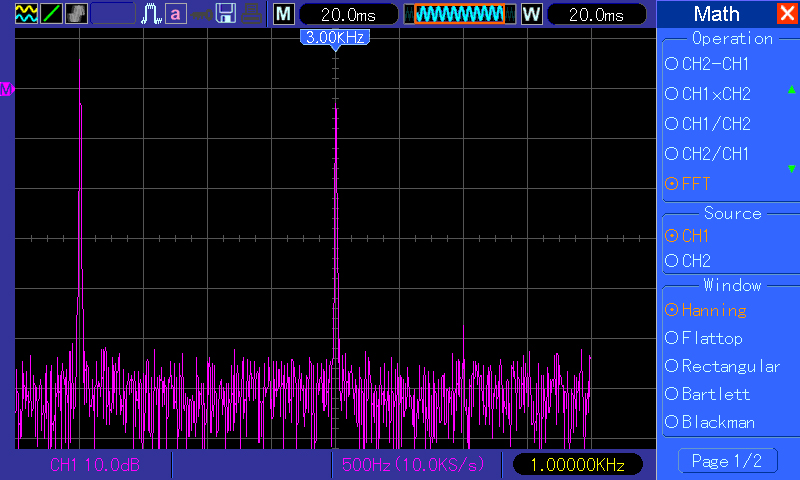
FFT display of 1 Khz Square wave. Notice the fundamental of 1 Khz and the 3rd harmonic at 3 Khz.
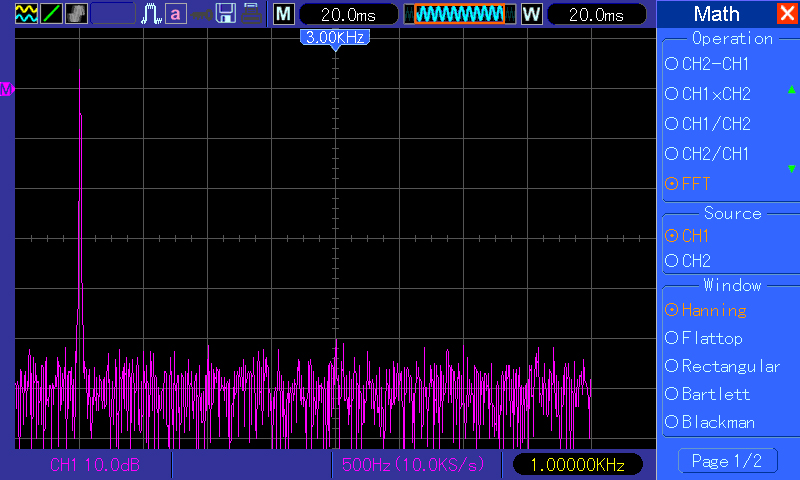
FFT display of 1 Khz Sine wave. Notice the fundamental of 1 Khz and no appreciable higher order harmonics.
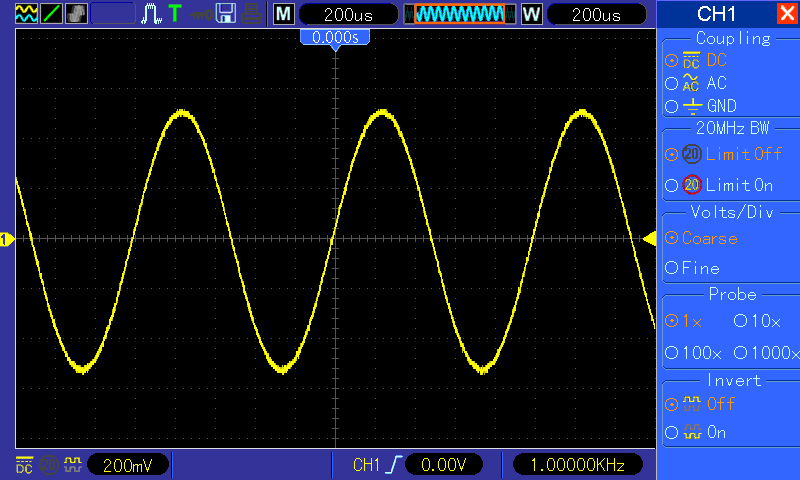
Normal scope display of the same 1 Khz Sine wave.
And perhaps the nicest “discovery” was that the price tags on many of these new models had really dropped incredibly from the $4,000.00 I paid for my old Tek unit. Several dual channel 100 MHz units were well below $800.00. So obviously the game has really changed in the DSO market and I was pleasantly surprised.
So, after quite a bit of time downloading and comparing specs, I eventually decided on the Hantek DSO5102B which is a dual channel 100 Mhz unit with 1 GS/a real time sampling rate and a more than adequate 1 MB memory depth ( aka sample points) It included the 7” LCD that I wanted and loads of other features. I looked at some other makers including ATTEN, Tektronics, RIGOL, TEKWAY and PROTEK but finally decided on Hantek’s DSO5102B unit which is made ( surprise surprise) in China. In fact, all of the new low cost units I considered were manufactured in China with the possible exception of the Tektronics unit which had a rather stiff price jump compared to the other makers.
So, then came the next step on where to buy my unit. I found plenty of web sites offering this unit at various prices and a lot of them were actually located in China or Hong Kong and the price offers were terrific. However, I wasn’t particularly comfortable purchasing the unit internationally as there would be no realistic return capability if something were to go wrong. Finally, I contacted Hantek directly & they referred me to Circuit Specialists located in Arizona. You can see their offer on this unit at www.circuitspecialists.com under their test equipment section. But when I went to their web site, I couldn’t find this model. So, I called them directly and spoke to the owner who informed me that they had received their evaluation samples of these new Hantek oscilloscopes and even though they were not yet being offered for sale on their web site, he agreed to sell me the DSO5102B that he had in his possession with full warranty & return privileges (I had 30 days to decide if it was the DSO for me with the right to return in “like new condition” if I felt it wasn’t suitable for my applications. My only risk was the shipping costs which sure beat the deals I could of gotten buying from China). And quite frankly, the price I paid was not that much higher than the China based supplier so my comfort level went through the roof.
So FINALLY I had my brand new shiny DSO and now I could really evaluate the unit hands on. The first thing I immediately liked about the Hantek DSO5102B was the wide screen high resolution color display. The screen measured 7” diagonally . It was just terrific, providing me with much higher resolution ( 800 x 480 pixels) compared to many other suppliers ( even some big names) who offer , in some cases, 340 x 240 pixel resolution. So the larger display and the terrific resolution provided me with an entirely new level of performance. I would compare it to going from regular t-v to hi def t-v and as my eyes age, this improvement in performance is greatly appreciated..
But the display is not the only feature that impressed me. The real time sampling rate extends up to 1GS/s for real time sampling (25GS/s Equivalent Sampling rate)…extremely impressive. Also, the memory depth extends up to a massive 1 MS for single channel operations and 512KS per channel when using both channels. More than enough for any application I could think of. Having deep sample memory (Sample Points) allows me to zoom in on any specific point in a sample record and examine it in detail. The DSO5102B provides a “zoom” function which makes it easy for me to do just that. The original waveform is shown in the upper screen window and the “zoomed in” area is shown in the lower window. This is illustrated in the following screen grab.
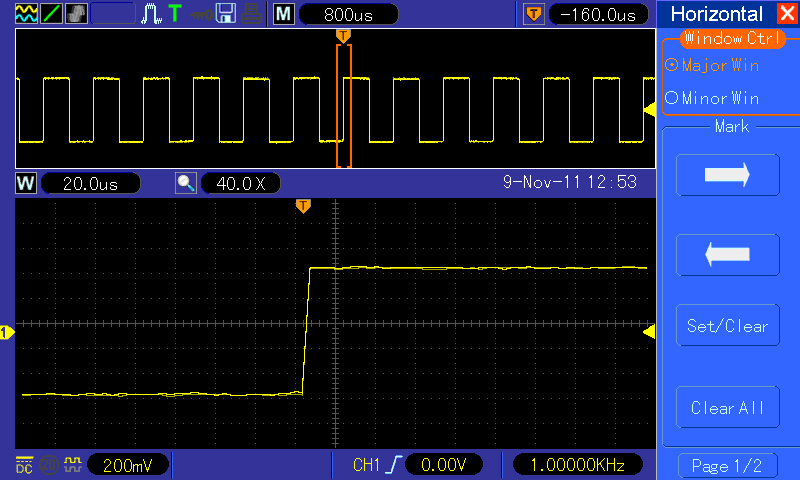
SOME KEY FEATURES
Another great feature of the Hantek DSO5102B is that it can update the acquired waveforms up to 2000 times per second which is way faster than any of the other models I looked at in this price range. This provides a very active “real time” display and with no trade off with the display brightness as I have seen on some other LCD screened DSO’s.
The “selectable persistence” display is offered on this unit. This option gives me a choice of ten different waveform display durations. I can select from “automatic” ( no persistence), 0.2s/0.4s/0.8s/1s/2s/4s/8s or infinite.
There is an automatic setup mode (“Auto Set”) function and this model also offers an internal self-calibration function which is selected from the utility menu simply by touching 1 button.
Built in real time clock and calendar is built in to the DSO5102B. Time and date are displayed on several of the measurement screens which can be saved and exported on screen grabs as you can see from the screen shot below.
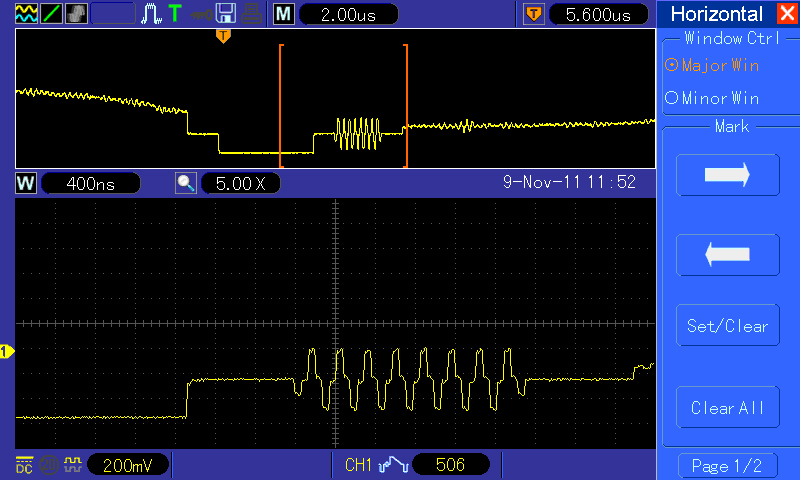 Another example of the “ZOOM” feature showing the color burst signal on the backporch of the Horizontal sync pulse.
Another example of the “ZOOM” feature showing the color burst signal on the backporch of the Horizontal sync pulse.
As far as acquisition modes and triggering options. The 5102B provides pretty much everything found on even the big name ( read expensive) DSO’s. For example: Waveforms can be acquired in one of four different modes: real-time sampling, peak-detect (aka averaging with a selection of 4,16, 64 or 128 waveforms) and also equivalent-time sampling. The sample point memory depth may also be set to 4KS, 16KS,40KS or 512KS and even 1MS for single channel operation.
- Pulse Width (20ns-10s, with positive or negative width plus a choice of <,> = or /= to a referenced pulse width)
- Edge ( rising or falling)
- Slope (trigger on a positive or negative slope</>=//= to a set time span of 20ns to 10s)
- Video (NTSC, PAL or SECAM, field select or line select(line1-line525 for NTSC, 1-625 for PAL or SECAM)
- Overtime ( delayed triggering which is when triggering is delayed by a nominated duration of time from either a positive or a negative edge. The delay time can be set between 20ns and 10s)
- Alternate/Swap Trigger) (the oscilloscope triggers from each channel alternately with a different triggering mode and/or sweep frequency for each trigger event)
 Display showing the special triggering feature with the ability to view one line of a composite video signal (line 506).
Display showing the special triggering feature with the ability to view one line of a composite video signal (line 506).
Triggering System Holdoff
Also, the triggering system on the Hantek DSO5102B provides a holdoff facility. This allows me to prevent the oscilloscope from triggering again for a nominated time after each triggering. This is a terrific feature for capturing individual bytes or words in a serial stream. This unit also provides a choice of HF reject, LF reject and noise rejection filters to improve triggering reliability.
Also, there is an impressive selection of automatic waveform measurements. Any of these may be applied to either one of the two channels: Frequency ( with six digit resolution), arithmetic mean voltage, period, peak-to-peak voltage, minimum, maximum, cycle RMS, rise time, fall time, positive width and negative width. A maximum of 8 of these measurements may be taken and displayed on the screen.
With all of these automatic measurement features available, this scope still provides the ability to make “manual” measurements between pairs of voltage or time cursors . It can even “trace” the time and voltage values at any desired point on a waveform using a single time cursor.
Also worth noting is that while the DSO5102B displays many measurements in the menu column at the right side of the display, this column may be hidden at any time with a simple press of a button. This choice will now provide the entire full screen width making it available for examining a waveform ( if you need it). Push the same button again and the right hand menu column reappears.
It goes without saying that this DSO provides the typical waveform math functions: Ch1 + CH2 ; CH1 – CH2, CH2-CH1; and FFT. In the FFT mode, I can choose between Haning, Flatop and Rectangular window functions. There is also an FFT “ZOOM” button to resize the horizontal magnification of the FFT display window. Choices are: x1, x2, x5 or x10. Cursors may also be used to make two measurements within the FFT spectrum: amplitude in dB (relative to 1V) & frequency in Hz.
USB Ports (2)
As do most of the latest Digital Scopes, the DSO5102B supplies a host USB port on the front panel allowing me to store waveforms and setups to a standard USB flash drive or thumb drive. The same usb port may be used to update the oscilloscope’s internal firmware, using files downloaded from Hantek’s web site and copied over to a USB flash drive. Once the files are copied, you just plug the drive into the port and then select the “Utility” menu and then press “Software Upgrade” and then “Confirm” ..Voila ! Upgrade completed.
Then, on the rear of the DSO is a USB Device port. This allows me to hook the DSO directly to a desktop or notebook computer using a standard USB cable. . Then, running a software called “TTScope” (supplied with the unit or available at the Hantek website at no cost) on the computer I am able to display screens and setups can be transferred between the DSO & PC in either direction and the oscilloscope can even be “driven” through a virtual front panel on the computer screen.
HELP SYSTEM
Super cool is the built in HELP SYSTEM. The HELP system provides relevant on-screen help at any time simply by pressing the HELP button. Basicly, this feature has made it almost unnecessary to refer to the manual ( the manual is supplied as a pdf file on a CD). Super feature and made getting used to the Hantek DSO5102B a snap. Here’s a screen shot with the HELP button enabled. I can imagine this feature being extremely important to anyone who does not have a lot of experience using digital storage oscilloscopes.
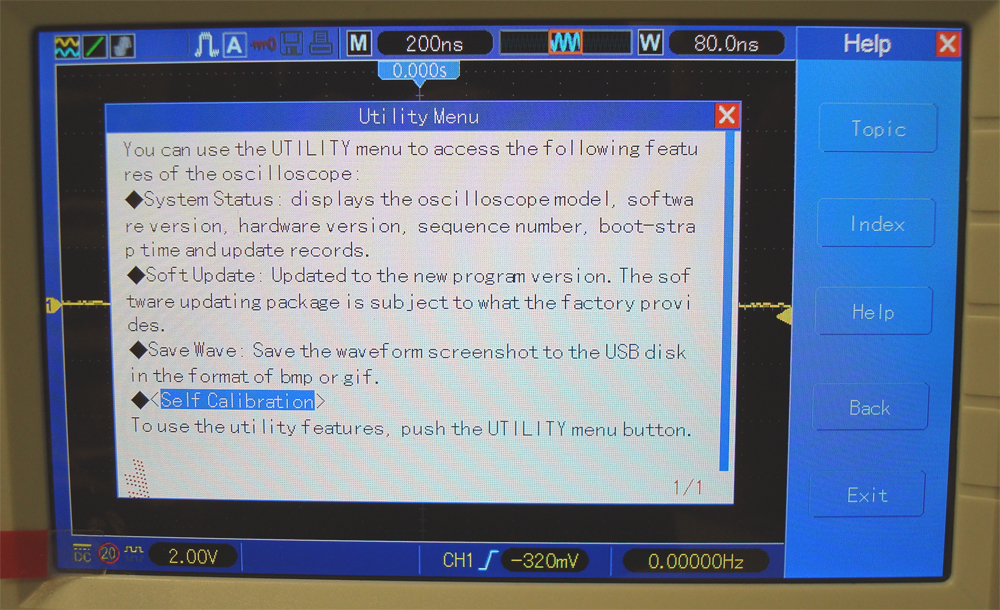 The DSO5102B’s Help Screen
The DSO5102B’s Help Screen
PRESS to CENTER
The vertical & horizontal position controls have a handy “press to center” option and the horizontal time base control has a similar feature making it extremely easy to make adjustments when using horizontal zoom magnification.
As is typical with most DSO’s, the DSO5102B also incorporates a 1kHz squarwave signal output on the front panel to simplify adjusting the probe compensation. Two high quality x10/x1 probes re supplied with a 100 MHz bandwidth in the x10 position and a 6MHz badwidth in the x1 position.
All in all, I am extremely impressed with Hantek’s design, quality and features. The casing is quite sturdy & compact with an integrated carrying handle and swing down adjustable feet. It weighs a mere 4.6 lbs. At the time I wrote this review, this oscilloscope was available online for about $550.00 U.S. A terrific product at a terrific price ! If there are any regrets it’s that I didn’t spring for their 200 Mhz version . The Hantek DSO5202B which provides identical features and functions but with a 200 MHz bandwidth.
MORE INFO:
- Hantek’s web site: www.hantek.com/english/produce_list.asp?unid=78
- Circuit Specialists, Inc www.CircuitSpecialists.com
